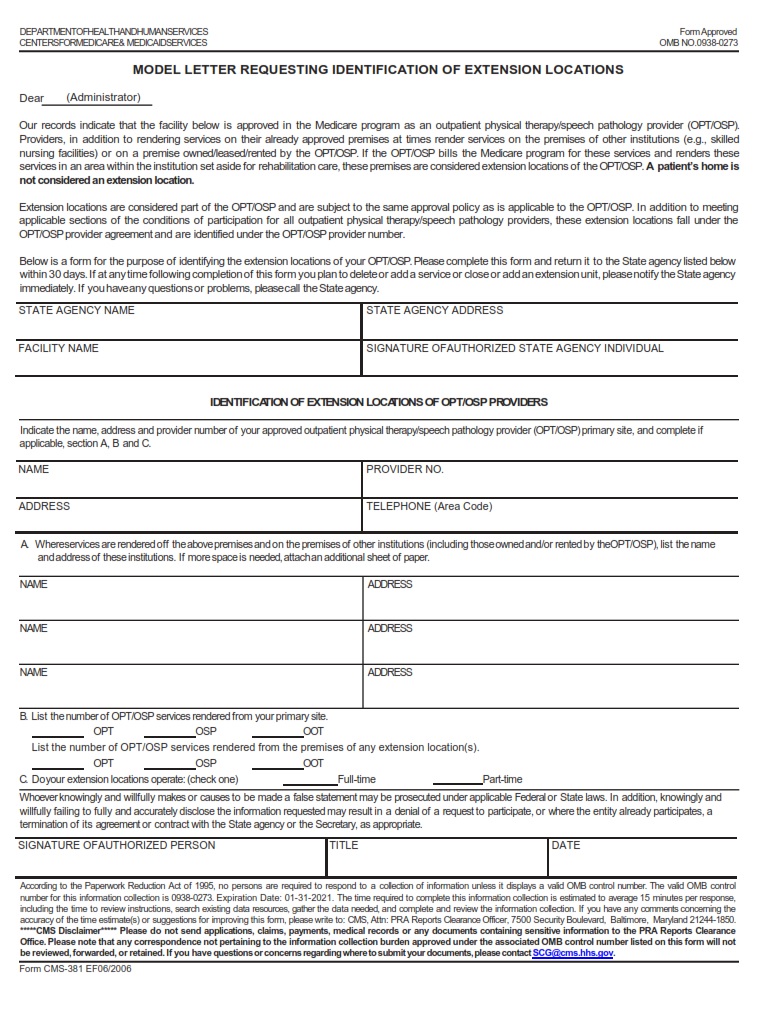CMSFORM.ORG – CMS 381 – MODEL LETTER REQUESTING IDENTIFICATION OF EXTENSION LOCATIONS – Imagine a world where your online presence is like a puzzle missing a vital piece, leaving you with an incomplete picture of your reach and impact. In today’s digital age, understanding the true extent of your brand’s footprint across various platforms is crucial for strategic decision-making and growth. This is where CMS 381 comes into play – a powerful tool designed to unveil the hidden gems of extension locations that could be shaping the narrative of your online identity. By sending out model letters requesting identification of these elusive corners of cyberspace, businesses can finally connect the dots and unlock new opportunities for expansion and engagement. Join us on a journey through this uncharted territory as we delve deep into the art of mapping out your digital domain with precision and purpose.
Download CMS 381 – MODEL LETTER REQUESTING IDENTIFICATION OF EXTENSION LOCATIONS
| Form Number | CMS 381 |
| Form Title | MODEL LETTER REQUESTING IDENTIFICATION OF EXTENSION LOCATIONS |
| Published | 2005-12-01 |
| O.M.B. | 0938-0273 |
| File Size | 54 KB |
CMS 381 - MODEL LETTER REQUESTING IDENTIFICATION OF EXTENSION LOCATIONS (691 downloads )
What is a CMS 381?
CMS 381, short for the Model Letter Requesting Identification of Extension Locations, plays a crucial role in streamlining communication between entities seeking to identify extension locations and government agencies regulating such information. This powerful system simplifies the process of gathering essential data pertaining to extension locations, ensuring compliance and efficiency. By utilizing CMS 381, organizations can expedite the identification process while maintaining accuracy and adherence to regulations.
Furthermore, CMS 381 serves as a valuable tool for enhancing transparency and accountability in various industries by providing a standardized framework for requesting and sharing information on extension locations. Its user-friendly interface and comprehensive features enable businesses to easily navigate through complex regulatory requirements related to expansion activities. Embracing CMS 381 not only facilitates better communication between stakeholders but also fosters a culture of compliance that is essential in today’s dynamic business environment.
Where Can I Find a CMS 381?
Looking for a CMS 381 form but not sure where to find it? The first place you should check is the official website of the relevant organization or government agency that typically handles these types of forms. Additionally, many online platforms offer a wide range of form templates, including the CMS 381, which can be easily downloaded and filled out electronically. Another option is to visit your local government office or post office, as they often have physical copies available for in-person pickup.
If you’re still having trouble locating a CMS 381 form, reaching out directly to the organization requesting it may be your best bet. Sometimes specific extensions or departments within these organizations handle different types of forms, so speaking with someone directly can save you time and effort. Remember to always double-check that you are using the most up-to-date version of the form to ensure accuracy and efficiency in your paperwork process.
CMS 381 – MODEL LETTER REQUESTING IDENTIFICATION OF EXTENSION LOCATIONS
In today’s interconnected world, the need for accurate and timely information on extension locations is paramount. CMS 381 provides a structured approach to requesting identification of these crucial points, ensuring that organizations can effectively expand their reach and services. By utilizing this model letter, businesses can streamline their communication process with stakeholders and gather essential data to inform strategic decisions.
The detailed format of CMS 381 empowers companies to clearly outline their requirements for extension locations, leading to more targeted responses from recipients. This proactive approach not only facilitates effective planning but also enhances transparency within the organization. Moreover, by standardizing the request process through this model letter, businesses can establish a consistent framework for collecting location data, ultimately improving efficiency and decision-making capabilities.
